Originally published Thursday, March 20, 2014 The World’s Worst Loser.
This post concludes our series on Newton High basketball. Click for Part 1 and Part 2.
 |
| Coach John Ravenscroft NHS Basketball Coarch 1946-1958 |
Born in Newton on January 13, 1915, to Mason and Lucile A. Ravenscroft, John Ravenscroft had a difficult childhood. By age seven he was fatherless and frequently in trouble. However, he was “crazy about basketball.”
He played on the YMCA teams and was known to shoot baskets for eight hours a day “till my hands swelled up.” Ravenscroft credited Frank Lindley for straightening him up.
“He got me back in high school. He insisted I clean myself up; he took me to a clothing store and bought me a new suit for $10.”
Ravenscroft won a position on Newton’s varsity team as a junior in 1932/33. He was on the team that lost at the state finals in 1934.
“Basketball was the vehicle I rode out of the poorest section of town, the wrong side of the tracks. We were poor.” -Ravenscroft in Buller, p. 38
After graduating from Newton High School in 1934, he attended University of Colorado and was a member of Colorado’s 1940 Big Seven championship team. He graduated from Colorado in 1940 with a BS in Science and Mathematics. In 1958, he received his Masters in Education from University of Wichita (Wichita State). Throughout his career as a coach and teacher, he stressed the value of education.
Former player Ken Schlup recalled;
Ravenscroft always preached to us . . . when you graduate from Newton High School, you’re expected to go to college and get a degree.” -Ken Schlup in Buller, p. 40
Meanwhile, Coach Lindley was searching for a successor and someone who could continue the winning tradition at Newton High. In addition to playing under Lindley, Ravenscroft had served as assistant coach for two seasons. He was an excellent choice to succeed Coach Lindley.
Basketball was a very important part of the Newton community and a strong team was expected.
Former NHS Basketball player Ken Franz recalled;
Lindley Hall where we played at was sold out every game. Almost the whole place was reserved seats. I can remember getting out of school at 3:15 and there would be people lined up for blocks trying to get tickets for the few seats that we still had. I think we were kind of heralded as heroes, I guess.” (Elliott)
 |
| NHS Basketball Team, 1948 (lt-rt) Fred Schroeder, Harold Hauck, Bill Lienhard, Coach John Ravenscroft,Clay Gray, Lanoy Loganbill, Gordon Byler HCHM Photo Archives |
“The Basketball team the year we were seniors [1948] . . . had an aura of celebrity about them, even when they were separated, walking down the stairs or sitting in class. Maybe it was their height (after all they were the tallest team in the state) or their undenied success that removed them from the rest of us, buffered by some mystique of camaraderie or fate.” –Norma Werner Wilson, Our Journey: 1948-1998, p. 67.
Newton returned to the State Championship a year later and won.
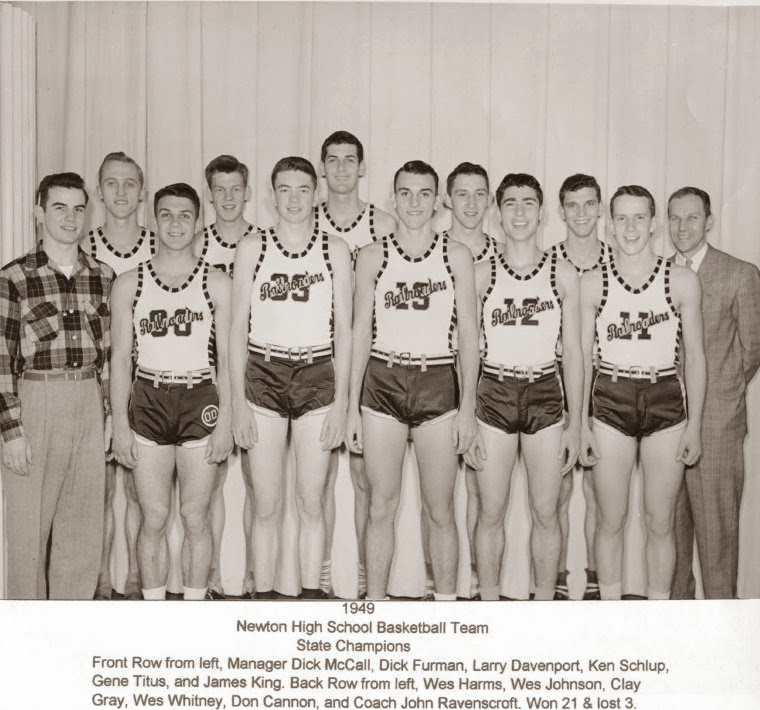 |
| NHS Basketball Team, State Champions, 1949 |
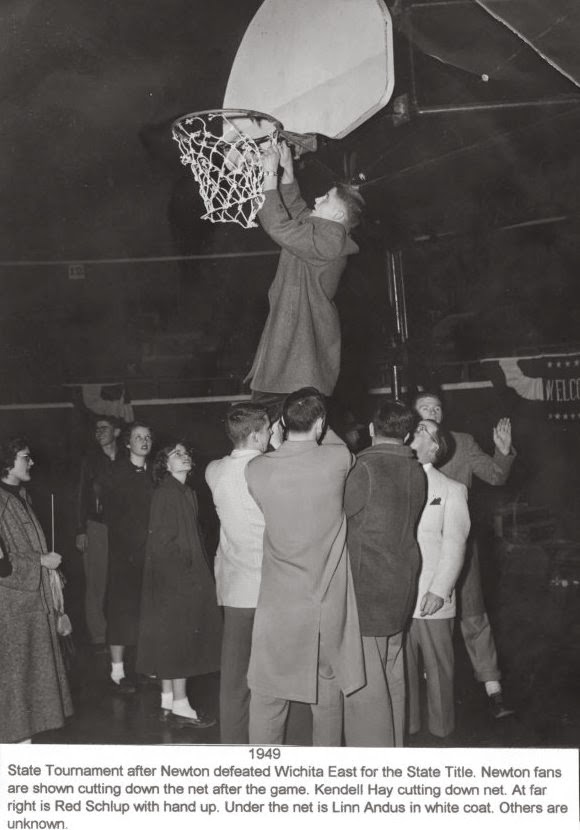 |
| Celebration after NHS beat Wichita East for the State Championship, 1949 HCHM Photo Archives |
| NHS Basketball Trophies, 1949 HCHM Photo Archives |
However, there was a darker side to the success. Not all students were allowed to try out for the basketball team. Perhaps Ravenscroft was able to make his most significant contribution to the community by insisting on the integration of the basketball team.
“I told him (Lindley) that I would take the job only if all kids got to play and we would do away with the separate Colored and Mexican teams.” –John Ravenscroft in Buller, p. 41
Until late 1940s, young men of color were not allowed to play on the High School basketball team. No matter how well they played. There were separate teams for the black and Hispanic students.
“Unable to . . . play for the Railroaders we formed our own Mexican team with a lot of support from our church and minority community. . . . We won three consecutive state championship held in Wichita in March. We competed against other Mexican teams from all over the state of Kansas, such as Wichita, Kansas City, Hutchinson, Topeka, Chanute. We were known as Wiley and McCall. Mr. McCall was our sponsor. He furnished us with brand new green and gold uniforms. -Ralph Perez, “’49er Memories . . . To Be a Minority,” Along the Golden Trail: 1949-1999, p. 95
 |
| Page from the 1944-1945 NHS Railroader |
“He (Lindley) let us use the old outdated basketball uniforms of the White team. Our coach was Jack Smith and he got permission to play one game in Lindley Hall because we were playing Tulsa and we knew the junior high gym would not accommodate the number of spectators we would have for that game.” –Clayton Garnett, Our Journey: 1948-1998, p. 82
|
NHS Basketball Team, 1953
Asst Coach Francis Markham, John Gonzalez, Don Bafus, Jim Rafferty, Gary Ewert, Vic Ewy,
Bob Boumgartner, Bill Embry, Jim Cadle, Don Peterson, Pete Charlton, Victor McCall,
Jach Bannon, John Reese, Bob Mellott, Raymond Hernandez, Bernie Castro,
Manger Lewis Bartel, and Coach John Ravenscroft
|
Just knowing that Bernie was out there on the court made the family so proud. Our proudest moment was in 1952 when Newton won the state championship. The next day the newspaper headline read, “The 1952 team led by the brilliant point guard Bernie Castro claimed the elusive title.” -Yolanda E. Gracia in Buller, p.40.
 |
| Bernie Castro The first minority student to play on the varsity team at NHS, 1952 |
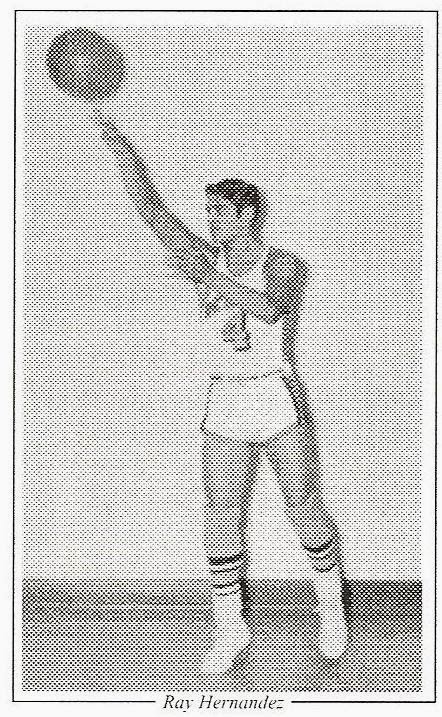 |
| Ray Hernandez |
“I was proud of all my players, and ever heard a single disparaging word concerning the minority players. I loved them all.” -Coach John Ravenscroft in Buller, p. 41.
Sources:
- HCHM Photo Archives
- Railroader NHS Annual for 1944-1945. HCHM Photo Archives
- Newton City Directories 1913-1943. HCHM Archives
- Newton Kansan, 17 March 1998. “John Ravenscroft was a teacher of men” editorial by Bill Wilson.
- Kansas Sports Hall of Fame – Ravenscroft, John at http://www/kshof.org.
- Wilson, Bill. “The kids mattered the most to John Ravenscroft” The Kansan 19 March 1998, p. 4.
- Buller, Curtis. Can’t You Hear the Whistle Blowing? Hesston, Ks: Prestige Printing, 1997
- Elliott, Chris. “Newton Was Basketball Royalty” at http://www.varsitykansas.com/2011/03/06/18172/newton-was-basketball-royalty.html
- Wilson, Norma Werner, ed. “Our Journey 50th Reunion Book: NHS 1948-1998“, 1999. HCHM Archives.
- “Along the Golden Trail, NHS 1949 50th Anniversary Book of Memories”, 1999. HCHM Archives.
- Kansas Prep Basketball History, Pt 3 – 5: Kansas High School Association Consolidation, 1916-1920. http://macfeesports.com/KS%20Prep%20Basketball%20History%20PT3.htm










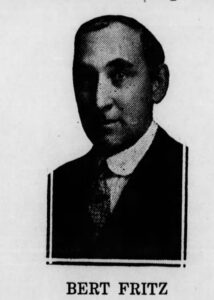


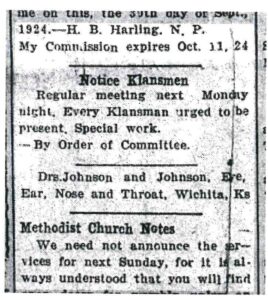


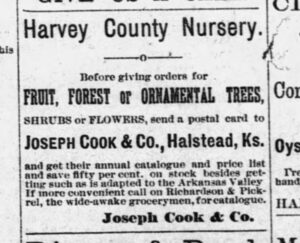

A note about Ravenscroft’s remark about teaching the team to shoot one-handed. Leason “Pete” McCloud started the one-handed shot when Ranscroft was in High School. Pete was scolded by Coach Lindley for shooting with one hand. This can be found in “Can’t hear the wistle blowing”. Pete is very well noted for being the one hand trouble.
Reply
Coach Ravenscroft was the most underappreciated man in Newton……EXCEPT by his players. Most all of us considered him the most important man in our life after our father. If NHS administration would have supported him in the “education” arena, where he took the most pride, he would have never left Newton.
Reply
I never had Ravenscroft as a coach or teacher but our families were friends. I remember our families going out to Western Kansas pheasant hunting. He was always a great friend to my father who never finished high school